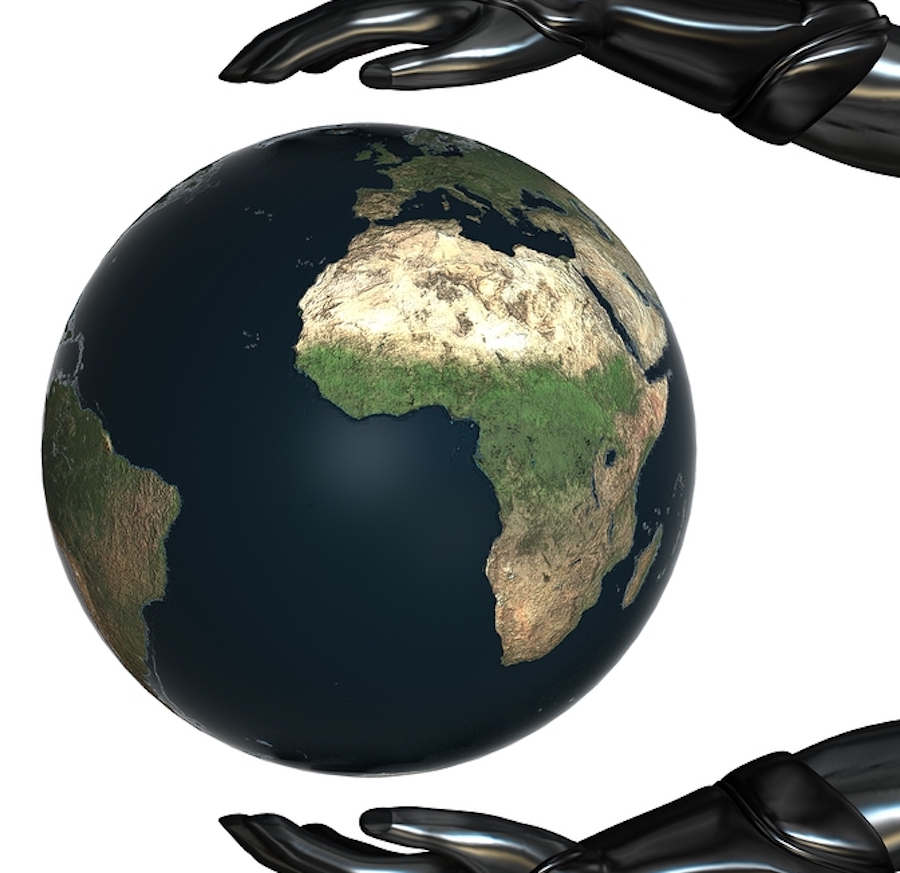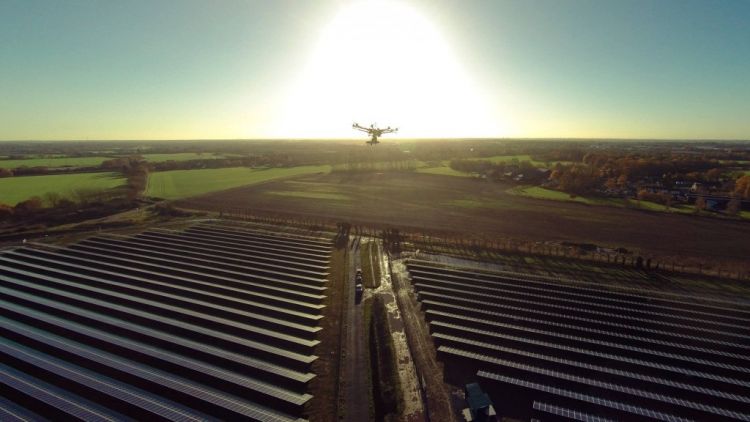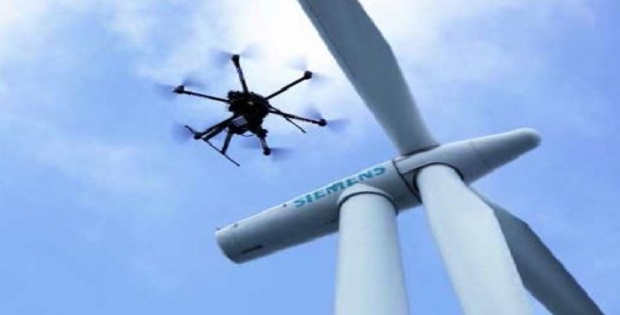
Robohub.org
Robots solving climate change

The two biggest societal challenges for the twenty-first century are also the biggest opportunities – automation and climate change. The confluence of these forces of mankind and nature intersect beautifully in the alternative energy market. The epitaph of fossil fuels with its dark cloud burning a hole in the ozone layer is giving way to a rise of solar and wind farms worldwide. Servicing these plantations are fleets of robots and drones, providing greater possibilities of expanding CleanTech to the most remote regions of the planet.

As 2017 comes to end, the solar industry for the first time in ten years has plateaued due to the proposed budget cuts by the Trump administration. Solar has had quite a run with an average annual growth rate of more than 65% for the past decade promoted largely by federal subsidies. The progressive policy of the Obama administration made the US a leader in alternative energy, resulting in a quarter-million new jobs. While the Federal Government now re-embraces the antiquated allure of fossil fuels, the global demand for solar has been rising as infrastructure costs decline by more than half, providing new opportunities without government incentives.
Prior to the renewal energy boom, unattractive roof tiles were the the most visible image of solar. While Elon Musk, and others are developing more aesthetically pleasing roofing materials, the business model of house-by-house conversion has been proven inefficient. Instead, the industry is focusing on “utility-scale” solar farms that will be connected to the national grid. Until recently, such farms have been straddled with ballooning servicing costs.
In a report published last month, leading energy risk management company DNV GL exclaimed that the alternative energy market could benefit greatly by utilizing Artificial Intelligence (AI) and robotics in designing, developing, deploying and maintaining utility farms. The study “Making Renewables Smarter: The Benefits, Risks, And Future of Artificial Intelligence In Solar And Wind” cited that “fields of resource forecasting, control and predictive maintenance” are ripe for tech disruption. Elizabeth Traiger, co-author of the report, explained, “Solar and wind developers, operators, and investors need to consider how their industries can use it, what the impacts are on the industries in a larger sense, and what decisions those industries need to confront.”

Since solar farms are often located in arid, dusty locations, one of the earliest use cases for unmanned systems was self-cleaning robots. As reported in 2014, Israeli company Ecoppia developed a patented waterless panel-washing platform to keep solar up and running in the desert. Today, Ecoppia is cleaning 10 million panels a month. Eran Meller, Chief Executive of Ecoppia, boasts, “We’re pleased to bring the experience gained over four years of cleaning in multiple sites in the Middle East. Cleaning 80 million solar panels in the harshest desert conditions globally, we expect to continue to play a leading role in this growing market.”
Since Ecoppia began selling commercially, there have been other entries into the unmanned maintenance space. This past March, Exosun became the latest to offer autonomous cleaning bots. The track equipment manufacturer claims that robotic systems can cut production losses by 2%, promising a return on investment within 18 months. After their acquisition of Greenbotics in 2013, US-based SunPower also launched its own mechanized cleaning platform, the Oasis, which combines mobile robots and drones.
SunPower brags that its products are ten times faster than traditional (manual) methods using 75% less water. While SunPower and Exosun leverage their large sales footprint with their existing servicing and equipment networks, Ecoppia is still the product leader. Its proprietary waterless solution offers the most cost-effective and connected solution on the market. Via a robust cloud network, Ecoppia can sense weather fluctuations to automatically schedule emergency cleanings. Anat Cohen Segev, Director of Marketing, explains, “Within seconds, we would detect a dust storm hitting the site, the master control will automatically suggest an additional cleaning cycle and within a click the entire site will be cleaned.” According to Segev, the robots remove 99% of the dust on the panels.

Drone companies are also entering the maintenance space. Upstart Aerial Power claims to have designed a “SolarBrush” quadcopter that cleans panels. The solar-powered drone professes to reduce 60% of a solar farm’s operational costs. Solar Brush also promises an 80% savings over existing solutions like Ecoppia since there are no installation costs. However, Aerial Power has yet to fly its product in the field as it is still in development. SolarPower is selling its own drone survey platform to assess development sites and oversee field operations. Matt Campbell, Vice President of Power Plant Products for SunPower, stated “A lot of the beginning of the solar industry was focused on the panel. Now we’re looking at innovation all around the rest of the system. That’s why we’re always surveying new technology — whether it’s a robot, whether it’s a drone, whether it’s software — and saying, ‘How can this help us reduce the cost of solar, build projects faster, and make them more reliable?’”

In 2008, The US Department of Energy published an ambitious proposal to have “20% Wind Energy by 2030: Increasing Wind Energy’s Contribution to U.S. Electricity Supply.” Presently at thirteen years before the goal, less than 5% of US energy is derived from wind. Developing wind farms is not novel, however to achieve 20% by 2030 the US needs to begin looking offshore. To put it in perspective, oceanic wind farms could generate more than 2,000 gigawatts of clean, carbon-free energy, or twice as much electricity as Americans currently consume. To date, there is only one wind farm operating off the coast of the United States. While almost every coastal state has proposals for offshore farms, the industry has been stalled by politics and servicing hurdles in dangerous waters.
For more than a decade the United Kingdom has led the development of offshore wind farms. At the University of Manchester, a leading group of researchers has been exploring a number of AI, robotic and drone technologies for remote inspections. The consortium of academics estimates that these technologies could generate more than $2.5 billion by 2025 in just the UK alone. The global offshore market could reach $17 billion by 2020, with 80% of the costs from operations and maintenance.
Last month, Innovate UK awarded $1.6 million to Perceptual Robotics and VulcanUAV to incorporate drones and autonomous boats into ocean inspections. These startups follow the business model of successful US inspection upstarts, like SkySpecs. Launched three years ago, SkySpecs’ autonomous drones claim to reduce turbine inspections from days to minutes. Danny Ellis, SkySpecs Chief Executive, claims “Customers that could once inspect only one-third of a wind farm can now do the whole farm in the same amount of time.” Last year, British startup Visual Working accomplished the herculean feat of surpassing 2000 blade inspections.
In the words of Paolo Brianzoni, Chief Executive of Visual Working: “We are not talking about what we intend to accomplish in the near future – but actually performing our UAV inspection service every day out there. Many in the industry are using considerable amount of time discussing and testing how to use UAV inspections in a safe and efficient way. We have passed that point and have alone in the first half of 2016 inspected 250 turbines in the North Sea averaging more then 10WTG per day, and still keeping to the “highest quality standards.’”
This past summer, Europe achieved another clean-energy milestone with the announcement of three new offshore wind farms for the first time without government subsidies. By bringing down the cost structure, autonomous systems are turning the tide of alternate energy regardless of government investment. Three days before leaving office, President Barack Obama wrote in the journal Science last year that “Evidence is mounting that any economic strategy that ignores carbon pollution will impose tremendous costs to the global economy and will result in fewer jobs and less economic growth over the long term.” He declared that it is time to move past common misconceptions that climate policy is at odds with business, “rather, it can boost efficiency, productivity, and innovation.”




